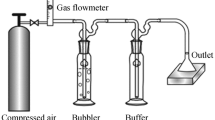Abstract
We use solution immersion method to prepare the SiO2 network structure. A single-layer PS sphere template was immersed in SiO2 precursor solution for a certain period of time. Filter paper was used to absorb the residual liquid, and then the PS nanospheres were removed by high temperature-annealing to form SiO2 network structure. The Si honeycomb structure was formed on the SiO2 network structure by chemical vapor deposition method. The longer growth time caused the smaller sizes of the Si apertures and produced various quantum size effects. When the growth time is 15 min, the thermal conductivity of the sample is the lowest. The heat conduction behavior of the 15 min sample is similar to that of a phonon crystal due to the aperture size of the sample is almost the same as the mean free path of phonons. Scattering at the interface of the isolated honeycomb microstructures also contributed to the low thermal conductivity. The position and number of the reflection peak of the sample can be controlled by the deposition time. The luminescence properties of the samples are greatly influenced by the surface topography.





Similar content being viewed by others
References
R.A. Lai, T.M. Hymel, V.K. Narasimhan, Y. Cui, Schottky barrier catalysis mechanism in metal-assisted chemical etching of silicon. ACS Appl. Mater. Interfaces 8(14), 8875–8879 (2016)
Y. Wei, M. Hu, W. Yan, D. Wang, L. Yuan, Y.X. Qin, Hydrothermal synthesis porous silicon/tungsten oxide nanorods composites and their gas-sensing properties to NO2 at room temperature. Appl. Surf. Sci. 353, 79–86 (2015)
I.A. Levitsky, Porous silicon structures as optical gas sensors. Sensors 15(8), 19968–19991 (2015)
L. Passoni, L. Criante, F. Fumagalli, F. Scotognella, G. Lanzani, F. Di. Fonzo, Self-assembled hierarchical nanostructures for high-efficiency porous photonic crystals. ACS Nano 8(12), 12167–12174 (2014)
M. Lajvardi, H. Eshghi, M.E. Ghazi, M. Izadifard, A. Goodarzi, Structural and optical properties of silicon nanowires synthesized by Ag-assisted chemical etching, Mat Sci Semicon Proc 40, 556–563 (2015)
T. Bitzer, Honeycomb Technology (Chapman and Hall, London, 1997)
C. Qi, C.C. Striemer, T.R. Gaborski, J.L. Mcgrath, P.M. Fauchet, Influence of silicon dioxide capping layers on pore characteristics in nanocrystalline silicon membranes. Nanotechnology 26(5), 055706 (2015)
Z. Zhang, Z.M. Xu, T.Y. Sun, H.F. Xu, C.H. Chen, Study on porous silicon template for nanoimprint lithography. Acta Phys Sin. 63(1), 018102-1–018102-8 (2014)
Y. Xia, J.A. Rogers, K.E. Paul, G.M. Whitesides, Unconventional methods for fabricating and patterning nanostructures. Chem. Rev. 99, 1823–1848 (1999)
B.D. Smith, J.J. Patil, N. Ferralis, J.C. Grossman, Catalyst self-assembly for scalable patterning of Sub 10 nm ultrahigh aspect ratio nanopores in silicon. ACS Appl. Mater. Interfaces 8(12), 8043–8049 (2016)
K.W. Tan, B. Jung, J.G. Werner, E.R. Rhoades, M.O. Thompson, U. Wiesner, Transient laser heating induced hierarchical porous structures from block copolymer-directed self-assembly. Science 349(6243), 54–58 (2015)
F. Burmeister, C. Schäfle, B. Keilhofer, C. Bechinger, J. Boneberg, P. Leiderer, From mesoscopic to nanoscopic surface structures: lithography with colloid monolayers. Adv Mater. 10(6), 495–497 (1998)
C.W. Kuo, J. Shiu, Y.H. Cho, P. Chen, Fabrication of large-area periodic nanopillar arrays for nanoimprint lithography using polymer colloid masks. Adv. Mater. 15, 1065–1068 (2003)
J. Rybczynski, U. Ebels, M. Giersig, Large-scale, 2D arrays of magnetic nanoparticles. Colloids surf. A 219(1–3), 1–6 (2003)
Z. Zang, A. Nakamura, J. Temmyo, Nitrogen doping in cuprous oxide films synthesized by radical oxidation at low temperature. Mater. Lett. 92, 188–191 (2013)
Z. Zang, A. Nakamura, J. Temmyo, Single cuprous oxide films synthesized by radical oxidation at low temperature for PV application. Opt. Express 21, 11448–11456 (2013)
S. F. Leung, M. Yu, Q. Lin, K. Kwon, K. L. Ching, L. Gu, K. Yu, Z. Fan, Efficient photon capturing with ordered three-dimensional nanowell arrays. Nano. Lett. 12, 3682–3689 (2012)
Y. Wu, X.X. Zhai, C.M. Zhen, X.W. Liu, L. Ma, D.L. Hou. A method for preparation of ordered porous silicon based on a 2D SiO2 template. Chin. Phys. Lett. 33(5), 058103 (2016)
Z. G. Li, Y. Gu, Y. P. Li, S. S. Feng, Z. R. Yang, Y. H. Zhang, H. B. Zeng, Hemi-shell arrays harvesting ultra-broadband light. Adv. Optical Mater. 3(7), 931–936 (2015)
M. Nomura, J. Nakagawa, Y. Kage, J. Maire, D. Moser, O. Paul, Thermal phonon transport in silicon nanowires and two-dimensional phononic crystal nanostructures. Appl. Phys. Lett. 106, 143102 (2015)
S. Alaie, D.F. Goettler, M. Su, Z.C. Leseman, C.M. Reinke, I. El-Kady. Thermal transport in phononic crystals and the observation of coherent phonon scattering at room temperature. Nat. Commun. 6, 7228 (2015)
J.Y. Tang, H.T. Wang, D.H. Lee, M. Fardy, Z. Huo, T.P. Russell, P.D. Yang, Holey silicon as an efficient thermoelectric material. Nano Lett. 10, 4279–4283 (2010)
X. Wang, Y. Wu, X.W. Liu, J.Y. Chen, C.M. Zhen, L. Ma, D.L. Hou, A template-based method for preparing ordered porous silicon. J. Porous Mater. 22, 1431–1435 (2015)
X. Wang, C.M. Zhen, X.W. Liu, X.M. Liu, L. Ma, C.F. Pan, D.L. Hou, A new hole-bridge structure based on a SiO2 nanoarray and its ferromagnetism. Colloids Surf. A 446, 151–155 (2014)
Acknowledgements
This work was partly supported by the National Natural Science Foundation of China (Grant Nos. 10804026 and 11504247), Natural Science Foundation of Hebei Province (A2013205101 and A2014205051), Hebei talent engineering (A201400119), and Graduate innovation support program (sj2016022).
Author information
Authors and Affiliations
Corresponding author
Rights and permissions
About this article
Cite this article
Wu, Y., Wang, P., Zhen, C. et al. Fabrication and optical properties of the Si honeycomb structure via colloidal monolayer template. J Porous Mater 25, 23–28 (2018). https://doi.org/10.1007/s10934-017-0416-z
Published:
Issue Date:
DOI: https://doi.org/10.1007/s10934-017-0416-z




